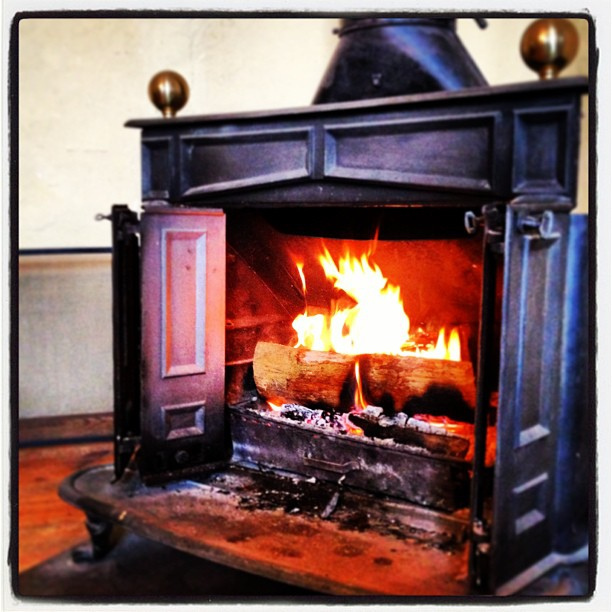Benjamin Franklin’s stove, an innovative design from the 18th century, reflects not just Franklin’s ingenuity but also his keen awareness of climate adaptation during extreme weather conditions. As detailed in Joyce Chaplin’s insightful book, *The Franklin Stove: An Unintended American Revolution*, this lesser-known invention aimed to improve heating efficiency while using less wood, a necessity during the harsh winter of 1740-41 when many suffered from the cold. By leveraging the principles of convection, Franklin’s stove not only provided warmth to homes but also contributed to a greater understanding of atmospheric phenomena like the Gulf Stream, which he famously mapped. This historical invention represents a pivotal moment in the intersection of science and technology, showcasing how human innovation can confront environmental challenges. Ultimately, Franklin’s work with the stove furthered a transformative dialogue about weather, comfort, and the responsible use of natural resources, which is still relevant today.
The creation of the Franklin stove, a remarkable advancement in heating technology, exemplifies the impact of innovative designs on everyday living during a time of climatic adversity. Referred to in discussions of early American ingenuity, this fireplace model not only improved domestic warmth but also ignited conversations about environmental dynamics and energy efficiency. The intellectual legacy of Benjamin Franklin intersects various realms, including scientific exploration and the realm of historical inventions, as highlighted in Chaplin’s recent analysis. As we explore this pivotal device, we uncover the intricate links between human comfort, resource management, and the scientific understanding of our atmosphere. Such explorations remind us of the importance of historical narratives in addressing modern challenges related to climate adaptation and sustainability.
The Revolutionary Design of Benjamin Franklin’s Stove
Benjamin Franklin’s stove, also known as the Pennsylvania fireplace, was a remarkable innovation that emerged during a notably harsh winter in the early 18th century. Invented in 1740, the stove was a revolutionary adaptation for colonial homes, allowing colonists to warm their spaces more efficiently while using less wood as fuel. This invention represented more than just a means for heating; it was a response to the critical environmental conditions of the Little Ice Age. Franklin’s engineering approach aimed to enhance indoor comfort, addressing the urgent needs of a growing population facing the challenges of cold weather.
By cleverly utilizing flat plates of iron, the Franklin stove promoted improved air circulation and optimal heat distribution. The design not only made rooms warmer but also highlighted Franklin’s ingenuity in solving practical problems. With its capacity to burn coal instead of wood in later versions, Franklin’s stove fundamentally altered how energy consumption was viewed and utilized in homes, paving the way for future advancements in heating technology. His work showcased the potential of scientific invention to respond dynamically to climatic challenges and societal needs.
Franklin’s Contributions to Climate Adaptation
Franklin’s innovative spirit was not limited to just the stove; he also contributed significantly to understanding climate adaptation in America. During the extreme winter of 1740-41, he recognized that as the population expanded, wood would become a scarce resource due to deforestation. This foresight led him to create a stove that would maximize heat generation while minimizing the amount of wood burned, thus addressing both immediate comfort needs and environmental sustainability. The Franklin stove was an essential component of his broader vision for a society that could withstand and adapt to changing climatic conditions.
Chaplin’s exploration of Franklin’s work reveals how this visionary thinker linked technology and nature, embodying Enlightenment ideals. As Franklin observed atmospheric phenomena, he proposed innovative ways to harness the elements to improve human living conditions. His work with the stove exemplified the belief that through careful observation and scientific understanding, humanity could develop solutions to enhance resilience against the capricities of nature. This legacy of integrating technology with environmental consciousness continues to resonate as society faces contemporary climate challenges.
The Impact of Historical Inventions on Modern Climate Understanding
The legacy of historical inventions such as the Franklin stove provides valuable insights into how technology can shape our understanding of climate issues today. As Joyce Chaplin discusses in her book, innovations from the past are not just relics; they are foundational elements that inform modern scientific inquiry and environmental policy. The Franklin stove, by demonstrating effective heat management, assists in propelling discussions on sustainable living practices that reduce carbon emissions and enhance energy efficiency.
Moreover, Franklin’s stove serves as an early example of how inventions can catalyze new thinking about environmental stewardship. As we explore modern technologies aimed at addressing climate change, we can learn from Franklin’s approach of blending observation, experimentation, and practical application. Embracing the spirit of his work, contemporary innovators can develop sustainable solutions that honor both the needs of society and the imperatives of environmental preservation, drawing lessons from the past to inform the future.
The Role of Atmosphere in Franklin’s Scientific Exploration
Ben Franklin’s curiosity about atmospheric phenomena was fundamentally linked to his invention of the stove. He employed the concept of convection to explain how heated air behaves, an insight that not only informed the design of his fireplace but also allowed him to conceptualize broader atmospheric systems. The atmosphere was a relatively new term used to describe the layers surrounding Earth, and Franklin’s stove represented an early canary in the coal mine approach to understanding how air density and temperature could impact indoor environments and ultimately global weather patterns.
By relating the operation of his stove to natural processes, Franklin engaged the public in the scientific discourse of his time. He made complex ideas about air and heat accessible, helping to foster a culture of inquiry and understanding. This interplay of science and invention not only bolstered his reputation as a thinker but also heightened awareness around the importance of the atmosphere in both domestic and natural contexts, an understanding that is increasingly vital in today’s discussions about climate science.
Lessons from Franklin for Modern Technological Optimism
Franklin’s approach to science and technology reflects a form of techno-optimism that remains relevant in today’s discourse on climate solutions. The innovations he championed were driven by a belief in human agency to mitigate the adverse effects of environmental challenges through invention. Drawing parallels to modern times, Chaplin suggests that we must remain cautious of a single solution mentality and instead embrace a multitude of approaches to address the complexities of climate change.
As Franklin demonstrated with the stove, the path to sustainability is likely to require ongoing adaptation and a willingness to evolve solutions. His insistence on re-burn technology to minimize emissions exemplifies a forward-thinking approach that acknowledges the interconnectedness of scientific discovery and ecological responsibility. Following in his footsteps, it’s crucial for current strategists and innovators to apply diverse, intersectional methodologies to tackle imminent climate crises, combining insights from various disciplines and historical contexts.
Understanding Franklin’s Impact on Energy Use
The transition from wood to coal in the various iterations of Franklin’s stove exemplified a significant shift in energy use during his time. His recognition of the need for more efficient energy consumption reflected a deeper awareness of resource depletion and environmental impact. By innovating a heating system that utilized coal more effectively, Franklin not only improved the quality of life for many Americans but also initiated a dialogue about sustainable resource management that resonates in today’s environmental discussions.
This shift in energy use leads to ongoing debates about sustainable practices in the face of climate change. Franklin’s work encourages a re-examination of how modern societies consume energy and what more efficient alternatives could look like. Understanding the historic progression of energy consumption, as outlined by Chaplin, allows contemporary decision-makers to navigate the path towards reducing our reliance on non-renewable resources and underscores the importance of innovation in shaping a sustainable future.
Franklin’s Stove as a Catalyst for Comfortable Living
The Franklin stove not only revolutionized heating techniques but also contributed to the cultural discourse around comfort and domestic life during Franklin’s era. As winters grew harsher, the stove became more than just a technological advancement; it was a means to improve the standard of living for colonists. This invention became emblematic of how innovative thought can enhance quality of life, merging science with domestic challenges to create a more hospitable environment.
As Joyce Chaplin indicates, Franklin’s invention sparked a new relationship between people and their homes. No longer simply shelters against the elements, homes began to transform into spaces of comfort, made possible through modern conveniences. This evolution speaks to a fundamental human desire for comfort, suggesting that technological advancements must continue to emphasize improving the everyday experiences of people while aligning with sustainable practices and environmental stewardship.
Intersections Between Franklin’s Legacy and Modern Environmentalism
Joyce Chaplin’s exploration of Benjamin Franklin’s inventions illustrates a critical intersection between his historical legacy and contemporary environmentalism. Franklin’s practice of linking practical inventions to larger scientific principles offers a framework for modern innovators seeking solutions to climate challenges today. Emphasizing the importance of scientific literacy and innovation, his works can inspire a renewed sense of responsibility among current and future generations to protect and nurture the environment.
The lessons drawn from Franklin’s engineering of the stove prompt us to rethink our relationship with technology in the face of looming climate crises. As contemporary society looks for ways to enhance sustainability, the principles embedded in Franklin’s work—interconnectedness of science, technology, and social needs—become essential pillars in creating resilient systems. Investing in innovations that honor both human comfort and planetary health can lead to a more sustainable future, reflecting Franklin’s enduring influence on energy and environmental issues.
Reassessing Historical Narratives Surrounding the Franklin Stove
The Franklin stove stands as a testament to the intersection of innovation and societal needs, inviting a reassessment of how we view historical narratives around invention. Often overshadowed by Franklin’s other celebrated achievements, this particular invention reveals the practical applications of scientific inquiry in everyday life. By repositioning the Franklin stove as a vital part of his legacy, Joyce Chaplin encourages a reevaluation of how we perceive the contributions of early American inventors in shaping both their time and ours.
In understanding the context of the Franklin stove’s creation, we also uncover a richer narrative about the 18th-century colonial experience and its challenges. Aspects like climate adaptation and resource management that were crucial for Franklin become lenses through which we can analyze and appreciate historical inventions. This reflective process serves not only to honor the ingenuity of past inventors but also emphasizes the lasting significance of their contributions to contemporary environmental strategies.
Frequently Asked Questions
What is Benjamin Franklin’s stove and how did it revolutionize heating?
Benjamin Franklin’s stove, also known as the Franklin stove, was a groundbreaking invention designed to improve indoor heating efficiency. Developed during the harsh winter of 1740-1741, this iron fireplace design allowed colonists to use less wood while providing more heat compared to traditional fireplaces. Franklin’s stove not only offered better warmth but also sparked new thinking around climate adaptation and energy use.
How did the Franklin stove contribute to understanding atmospheric phenomena?
The Franklin stove played a pivotal role in enhancing the understanding of atmospheric phenomena. Benjamin Franklin illustrated how convection heat worked in his stove, explaining how warm air rises and circulates. This concept was later applied by Franklin to describe outdoor climate patterns, including storm systems and the Gulf Stream, showcasing his dual contributions to heating technology and meteorological science.
What were the environmental impacts of the Franklin stove during its invention?
During its invention, the Franklin stove addressed significant environmental challenges, especially during the Little Ice Age. Franklin recognized that as deforestation increased due to settlement expansion, firewood accessibility became an issue. His stove’s design meant less wood was needed for heat, promoting a more sustainable approach to heating during a time of climate strain.
In what ways did Joyce Chaplin’s book highlight the significance of the Franklin stove?
Joyce Chaplin’s book, “The Franklin Stove: An Unintended American Revolution,” emphasizes the importance of the Franklin stove as more than just a heating device. It illustrates how this invention catalyzed thoughts on environmental comfort, energy efficiency, and technological innovation, reflecting Franklin’s broader contributions to science and his understanding of climate adaptation.
Did Benjamin Franklin’s stove have any influence on modern heating solutions?
Yes, Benjamin Franklin’s stove paved the way for modern heating solutions by showcasing the benefits of efficient heating and reduced emissions. His design principles of maximizing heat output while minimizing fuel use resonate with contemporary efforts to develop environmentally friendly heating options, emphasizing the need for innovative technologies to address current climate challenges.
How did Franklin’s concerns about air quality influence the design of his stove?
Franklin was deeply aware of air quality issues, particularly in polluted cities like London. His later iterations of the Franklin stove aimed to minimize smoke emissions by re-burning smoke that would typically escape into the air. This innovation not only made the stove more efficient but also addressed concerns about air pollution, illustrating his forward-thinking approach to environmental health.
What lessons can we learn from Franklin’s approach to innovation in relation to climate crises?
Franklin’s approach to innovation reflects a critical lesson in addressing climate crises: the understanding that no single solution can solve complex problems. Chaplin’s book encourages us to be cautious of quick fixes and to pursue multiple strategies in tackling climate challenges, much like Franklin’s multifaceted contributions to science and technology.
| Key Points |
|---|
| Joyce Chaplin’s Book on Franklin’s Stove |
| Explores the invention’s impact on heating technology and atmospheric science |
| Invention developed during the cold winter of 1740-1741 to improve heating efficiency |
| Franklin created at least five versions of the stove over half a century |
| Stove helped advance understanding of atmospheric phenomena such as the Gulf Stream |
| Franklin aimed to minimize smoke emissions and improve air quality in urban areas |
Summary
Benjamin Franklin’s stove represents a pivotal yet often overlooked invention that not only transformed heating efficiency but also contributed to the evolving comprehension of atmospheric science during his era. Developed during an exceptionally harsh winter, Franklin’s stove was designed to provide more warmth with less wood, reflecting his innovative spirit and commitment to improving human comfort amidst environmental challenges. Through his work, Franklin laid the groundwork for further scientific inquiry into weather patterns and energy efficiency, demonstrating the profound connection between technology and the natural world. Ultimately, the legacy of Benjamin Franklin’s stove serves as a reminder of the necessity for continuous innovation in addressing both comfort and environmental sustainability.




